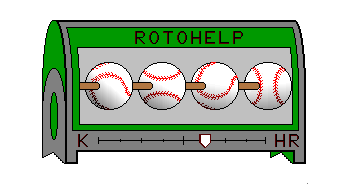 |
||
|
November 17th 2001 |
Your Daily Fantasy Rx |
|||||||||
|
|
by Tim Polko How We Value Players, Part Three Valuation Concepts Now that we've covered a couple ways to value players, we need to review some significant concepts in player valuation. An understanding of the value of these theories is vital to comparing Category Dollars with Standings' Gain Points. Position Scarcity All else being equal, which of these two players would you rather draft to fill your last roster spot in a 4x4 league:
At the draft table, you should be drafting with an eye towards positions with less talent. If you can acquire catchers, shortstops, second basemen, and even third basemen within a dollar or two of their predicted value, you should be willing to overbid slightly. However, this philosophy should NOT be a part of your draft day calculations. Every draft has different dynamics and owners need to be able to adapt to unexpected changes in the draft. Inflated prices for World Series players and top rookies are as much a part of most draft days as deflated prices for playoff goats and injured veterans. Planning to acquire talent somewhat limited at some positions is a fine strategy and one we heartily recommend, but as long as you spend your money on players you expect to meet or exceed their draft prices, there's no reason to plan on spending extra money at scarce positions. SGP allows you to change the marginal pricing SGP denominator for specific positions, but we believe this unfairly inflates the weaker position. Without this denominator modification, SGP loses one of its main advantages. Targeting weaker positions should only be draft strategy since the value of similar statistics at different positions remains nearly identical. We hope the above comparison of Anderson and Vander Wal will demonstrate to everyone's satisfaction that position scarcity does not exist in any way that should affects your draft values. Keeper Inflation Keeper inflation occurs when owners keep players at a price less than their projected value. The excess draft dollars need to be allocated, and they necessarily inflate the prices of the remaining players. Some pricing systems use the following simple inflation strategy: $3120 available cash - $520 existing contracts = $2600 remaining draft budget $3120 total player value - $780 of kept player value = $2340 of value left $2600 budget / $2340 value = 1.111, or about an 11% inflation factor. In this draft example, $10 players would now be worth $11, $20 players would be worth $22, etc. This is the absolute minimum calculation for keeper inflation, but unfortunately it doesn't provide you much of an advantage as your fellow owners likely also perform this value adjustment. The second step is to divide players into the hitter and pitcher pools. In this 12-team league, we'll draft 168 hitters and 108 pitchers. Using the standard 65/35 value split, we're left with $2028 for offense and $1092 for pitching. The calculations from above are then computed separately for position players and pitchers to determine the inflation factor for each group. We now have a better grasp of the value of hitters vs. pitchers, but several top keepers in a specific category can skew the numbers for everyone, as shown in yesterday's discussions of closers. Category Dollars allows you to easily compute category inflation in your spreadsheet by removing the kept player's statistics from your totals in each statistic. The only way to adjust for this with SGP is to change your denominators. While we have no problem with this as we believe that the denominator calculations possess overt inherent risk, we can't see this method working better than inflation with Category Dollars. Options Art McGee explains SGP in depth in How to Value Players for Rotisserie Baseball. McGee is a Chicago options' trader who has found a way to incorporate potential future value into draft value calculations. While his book is a very interesting discussion piece, we don't believe that incorporating future options into your draft values makes much sense. Most owners should be playing for the current season, and altering your values to account for future production, or even in-season transactions, doesn't accurately reflect draft day value. While you can target specific players that you believe have future upside, you should already be drafting players that you believe can exceed their projections for this season. Changing their prices to reflect potential beyond the current season adds another degree of risk to your values when one of our goals is to minimize the risk in our projections, and thereby project more accurate player values. The only exception to this policy would be for a team rebuilding due to joining a league as an expansion team or other similar circumstances when you don't begin with any keepers. Even then, you should still focus on the current season, and if you know your players and trust your projections, you should be able to finish in the money every year. Since this review of valuation concepts took longer than I expected, I'm going to save our final conclusions on which valuation system to use in different leagues until tomorrow. Today's Fantasy Rx: Since no one wrote in with their opinions of Harry Potter, I assume that everyone was busy learning their spreadsheet programs. For tomorrow, those of you in keeper leagues should start reviewing your league rosters to see what keepers you should target in trade. Pay special attention to talent at weaker positions, as securing catchers and shortstops allows you to have more flexibility at draft.
Click
here to read the previous article.
Please e-mail your comments to
tim@rotohelp.com. |
|||||||||||||||||||||||||||||||||||||||||||||||||||||||
|
Rotohelp |
||||||||||||
|
All content ©2001-18
Rotohelp, Inc.
All rights reserved. PO Box 72054 Roselle, IL 60172. Please send your comments, suggestions, and complaints to: admin@rotohelp.com. |
||||||||||||